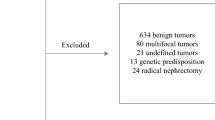Abstract
Purpose
We investigated the prognostic significance of tumor location at the renal hilum near the sinus structure on the recurrence in T1 renal cell carcinoma (RCC).
Methods
A total of 1,818 T1 RCC patients who underwent radical (RN) or partial nephrectomy (PN) from 1997 to 2011 were retrospectively reviewed. A hilar tumor was defined as a tumor abutting the main renal artery and/or vein or its segmental branches, without invasion. We compared the recurrence-free survival (RFS) rates between hilar and nonhilar T1 RCC and analyzed predictors of RFS after nephrectomy.
Results
Patients with hilar tumors showed a poorer 5-year RFS compared with nonhilar tumors both in T1a (89.7 vs. 98.5 %, p < 0.001) and T1b (81.6 vs. 95.1 %, p < 0.001) RCCs. Among patients who underwent RN and PN, hilar tumors were associated with lower 5-year RFS (87.6 vs. 97.2 % for RN, 78.1 vs. 98.2 % for PN, both p < 0.001). In T1a hilar tumor, PN was associated with poorer 5-year RFS than RN (79.5 vs. 93.0 %, p < 0.001). In multivariate analysis, a hilar location remained as an independent predictor of recurrence in both T1a and T1b tumors (both p = 0.001).
Conclusions
Hilar tumors show a higher recurrence rate than nonhilar counterparts in T1 RCC. In T1a hilar tumors, PN demonstrated poorer RFS than RN. Potential intrinsic renal anatomical or lymphovascular structural differences as well as differences in cancer characteristics need further investigations.


Similar content being viewed by others
References
Patard JJ, Tazi H, Bensalah K, et al. The changing evolution of renal tumours: a single center experience over a two-decade period. Eur Urol. 2004;45:490–3.
Kane CJ, Mallin K, Ritchey J, et al. Renal cell cancer stage migration: analysis of the National Cancer Data Base. Cancer. 2008;113:78–83.
Pichler M, Hutterer GC, Chromecki TF, et al. Renal cell carcinoma stage migration in a single European centre over 25 years: effects on 5- and 10-year metastasis-free survival. Int Urol Nephrol. 2012;44:997–1004.
Pantuck AJ, Zisman A, Belldegrun AS. The changing natural history of renal cell carcinoma. J Urol. 2001;166:1611–23.
Breda A, Konijeti R, Lam JS. Patterns of recurrence and surveillance strategies for renal cell carcinoma following surgical resection. Expert Rev Anticancer Ther. 2007;7:847–62.
Bertini R, Roscigno M, Freschi M, et al. Renal sinus fat invasion in pT3a clear cell renal cell carcinoma affects outcomes of patients without nodal involvement or distant metastases. J Urol. 2009;181:2027–32.
Thompson RH, Leibovich BC, Cheville JC, et al. Is renal sinus fat invasion the same as perinephric fat invasion for pT3a renal cell carcinoma? J Urol. 2005;174:1218–21.
Verhoest G, Avakian R, Bensalah K, et al. Urinary collecting system invasion is an independent prognostic factor of organ confined renal cell carcinoma. J Urol. 2009;182:854–9.
Gesase AP. Rare origin of supernumerary renal vessels supplying the lower pole of the left kidney. Ann Anat. 2007;189:53–8.
Fuhrman SA, Lasky LC, Limas C. Prognostic significance of morphologic parameters in renal cell carcinoma. Am J Surg Pathol. 1982;6:655–63.
Uzzo RG, Cherullo E, Myles J, et al. Renal cell carcinoma invading the urinary collecting system: implications for staging. J Urol. 2002;167:2392–6.
Poon SA, Gonzalez JR, Benson MC, et al. Invasion of renal sinus fat is not an independent predictor of survival in pT3a renal cell carcinoma. BJU Int. 2009;103:1622–5.
Margulis V, Tamboli P, Matin SF, et al. Location of extrarenal tumor extension does not impact survival of patients with pT3a renal cell carcinoma. J Urol. 2007;178:1878–82.
Bedke J, Buse S, Pritsch M, et al. Perinephric and renal sinus fat infiltration in pT3a renal cell carcinoma: possible prognostic differences. BJU Int. 2009;103:1349–54.
Thompson RH, Blute ML, Krambeck AE, et al. Patients with pT1 renal cell carcinoma who die from disease after nephrectomy may have unrecognized renal sinus fat invasion. Am J Surg Pathol. 2007;31:1089–93.
Simmons MN, Hillyer SP, Lee BH, et al. Diameter-axial-polar nephrometry: integration and optimization of R.E.N.A.L. and centrality index scoreing system. J Urol. 2012;188:384–90.
Kobayashi K, Saito T, Kitamura Y, et al. The RENAL nephrometry score and the PADUA classificatio for the prediction of perioperative outcomes in patients receiving nephron-sparing surgery: feasible tools to predict intraoperative conversion to nephrectomy. Urol Int. 2013;91:261–8.
Weight CJ, Atwell TD, Fazzio RT, et al. A multidisciplinary evaluation of inter-reviewer agreement of the nephrometry core and the prediction of long-term outcomes. J Urol. 2011;186:1123–8.
Gorin MA, Ball MW, Pierorazio PM, et al. Outcomes and predictors of clinical T1 to pathological T3a tumor up-staging after robotic partial nephrectomy: a multi-institutional analysis. J Urol. 2013;190:1907–11.
Disclosure
The authors declare no conflict of interest.
Author information
Authors and Affiliations
Corresponding author
Rights and permissions
About this article
Cite this article
Shim, M., Song, C., Park, S. et al. Hilar Location is an Independent Prognostic Factor for Recurrence in T1 Renal Cell Carcinoma After Nephrectomy. Ann Surg Oncol 22, 344–350 (2015). https://doi.org/10.1245/s10434-014-4153-0
Received:
Published:
Issue Date:
DOI: https://doi.org/10.1245/s10434-014-4153-0




